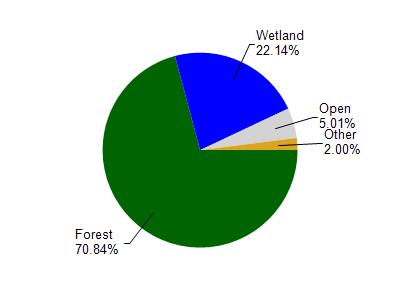Douglas
No
No
No
Fish and Aquatic Life
Overview
Leader Lake, in the Totagatic River Watershed, is a 171.06 acre lake that falls in Douglas County. This lake is managed for fishing and swimming and is currently not considered impaired.
Date 2011
Author Aquatic Biologist
Historical Description
This 161 acre seepage lake has an intermittent stream connection to Bond Lake and the two
shoreline communities have formed a joint lakes association. A self-help volunteer has recently
started collecting data on this lake also. Additional water quality monitoring and lake
management planning would be desireable for this lake.
Date 1992
Author Surface Water Inventory Of Wisconsin
General Condition
Leader Lake (2693800) was assessed during the 2016 listing cycle; chlorophyll sample data were clearly below 2016 WisCALM listing thresholds for Recreation use and Fish and Aquatic Life use. Total phosphorus sample data were clearly below FAL use listing thresholds and did not exceed REC listing thresholds. This water is meeting these designated uses and is not considered impaired.
Date 2015
Author Ashley Beranek
Condition
Wisconsin has over 84,000 miles of streams, 15,000 lakes and milllions of acres of wetlands. Assessing the condition of this vast amount of water is challenging. The state's water monitoring program uses a media-based, cross-program approach to analyze water condition. An updated monitoring strategy (2015-2020) is now available. Compliance with Clean Water Act fishable, swimmable standards are located in the Executive Summary of Water Condition in 2018. See also the 'monitoring and projects' tab.
Reports
Management Goals
Wisconsin's Water Quality Standards provide qualitative and quantitative goals for waters that are protective of Fishable, Swimmable conditions [Learn more]. Waters that do not meet water quality standards are considered impaired and restoration actions are planned and carried out until the water is once again fishable and swimmable
Management goals can include creation or implementation of a Total Maximum Daily Load analysis, a Nine Key Element Plan, or other restoration work, education and outreach and more. If specific recommendations exist for this water, they will be displayed below online.
Monitoring
Monitoring the condition of a river, stream, or lake includes gathering physical, chemical, biological, and habitat data. Comprehensive studies often gather all these parameters in great detail, while lighter assessment events will involve sampling physical, chemical and biological data such as macroinvertebrates. Aquatic macroinvertebrates and fish communities integrate watershed or catchment condition, providing great insight into overall ecosystem health. Chemical and habitat parameters tell researchers more about human induced problems including contaminated runoff, point source dischargers, or habitat issues that foster or limit the potential of aquatic communities to thrive in a given area. Wisconsin's Water Monitoring Strategy was recenty updated.
Grants and Management Projects
| Project Name (Click for Details) | Year Started |
|---|
|
|
Monitoring Projects
| WBIC | Official Waterbody Name | Station ID | Station Name | Earliest Fieldwork Date | Latest Fieldwork Date | View Station | View Data |
|---|
| 2693800 | Leader Lake | 10019065 | Leader Lake -- Access | 9/28/2011 | 8/7/2020 | Map | Data |
| 2693800 | Leader Lake | 10002143 | Leader Lake | 9/5/2000 | 9/12/2017 | Map | Data |
| 2693800 | Leader Lake | 163238 | Leader Lake - Near Deep Pt E Basin | 7/1/1991 | 9/26/2025 | Map | Data |
|

Watershed Characteristics
Leader Lake is located in the Totagatic River watershed which is 329.93 mi². Land use in the watershed is primarily forest (70.70%), wetland (22.10%) and a mix of open (5%) and other uses (2.00%). This watershed has 275.08 stream miles, 6,681.38 lake acres and 42,970.25 wetland acres.
Nonpoint Source Characteristics
This watershed is ranked Not Ranked for runoff impacts on streams, Not Ranked for runoff impacts on lakes and Low for runoff impacts on groundwater and therefore has an overall rank of Low. This value can be used in ranking the watershed or individual waterbodies for grant funding under state and county programs.This water is ranked High Lake for individual Lakes based on runoff problems and the likelihood of success from project implementation.